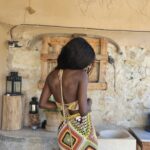A Quiet Tribute: Recognizing Kokrobitey’s Enduring Impact
Just outside Accra, along Ghana’s quiet coast, the Kokrobitey Institute has been shaping the future of fashion, sustainability, and education since 1992. Founded by Renée C. Neblett, the Institute is a rare space where design, environmental literacy, and African tradition coexist, not as buzzwords, but as daily practice. Set within earth-brick buildings crafted by the late architect Alero Olympio, it is at once a creative sanctuary and a classroom where students are taught not just to create, but to think, observe, and repurpose.
On June 7, 2025, a subtle yet meaningful recognition came from across the Atlantic. Elise McMahon, founder of the New York-based sustainable design studio LikeMindedObjects, shared a simple post on Instagram. No product drop. No new campaign. Just quiet gratitude: “Honoured to be featured alongside Renee C Neblett aka Auntie and the whole @kokrobitey.institute.” The post was more than a caption. It was a nod to a philosophy that values process over perfection, substance over spectacle. Kokrobitey has never relied on trends to prove its relevance. Its workshops — such as the annual Textiles Workshop and the newly supported Esi Project (2025–26), funded by the Bestseller Foundation — reflect its long-term vision: empowering youth and women through skills training, recycling waste into usable design, and promoting an African-led conversation around sustainability.
Here, used garments and industrial scraps aren’t discarded; they’re transformed. Fashion is not fast — it is local, grounded, and intentional. Materials like batik, kente, and upcycled plastics are integrated into wearable, thoughtful designs, redefining value through purpose and story. Elise McMahon’s quiet post was not an announcement of collaboration, but an acknowledgement of respect. In an industry too often driven by visibility and noise, Kokrobitey offers an alternative: a slower rhythm, a rooted presence, and a model of design that inspires without demanding attention. This isn’t just a feel-good story. It’s a timely reminder that the most powerful forces in fashion today might not be on runways — they might be happening in quiet workshops in Ghana, stitched together by hands that understand the land and minds that dare to imagine differently.
For Africa’s fashion future, Kokrobitey isn’t just participating. It’s leading slowly, surely, and with style.







